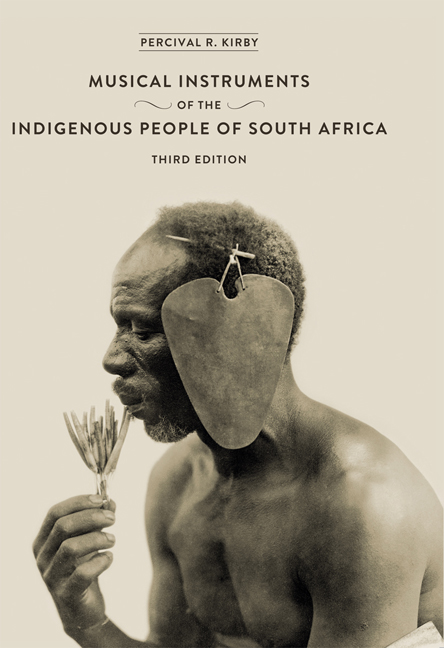Book contents
- Frontmatter
- Dedication
- Map
- Contents
- Foreword
- Preface to First Edition
- Preface to Second Edition
- Acknowledgements
- Acknowledgements to Third Edition
- List of Illustrations
- 1 Rattles and Clappers
- 2 Drums
- 3 Xylophones and ‘Sansas’
- 4 Bull-Roarers and Spinning-Disks
- 5 Horns and Trumpets
- 6 Whistles, Flutes, and Vibrating Reeds
- 7 Reed-Flute Ensembles
- 8 The ‘Gora’, A Stringed-Wind Instrument
- 9 Stringed Instruments
- 10 Bushman and Hottentot Violins and The ‘Ramkie’
- 11 Some European Instruments Played By Natives
- Appendix
- Addenda
- Index
11 - Some European Instruments Played By Natives
Published online by Cambridge University Press: 21 April 2018
- Frontmatter
- Dedication
- Map
- Contents
- Foreword
- Preface to First Edition
- Preface to Second Edition
- Acknowledgements
- Acknowledgements to Third Edition
- List of Illustrations
- 1 Rattles and Clappers
- 2 Drums
- 3 Xylophones and ‘Sansas’
- 4 Bull-Roarers and Spinning-Disks
- 5 Horns and Trumpets
- 6 Whistles, Flutes, and Vibrating Reeds
- 7 Reed-Flute Ensembles
- 8 The ‘Gora’, A Stringed-Wind Instrument
- 9 Stringed Instruments
- 10 Bushman and Hottentot Violins and The ‘Ramkie’
- 11 Some European Instruments Played By Natives
- Appendix
- Addenda
- Index
Summary
I HAVE already mentioned the fact that cheap European musical instruments tend, in some cases, to supplant the natives’ own. The chief varieties to be met with in trading stores are Jew's harps, mouth-harmonicas, ‘German’ concertinas, guitars, and autoharps. It should be pointed out that, of these instruments, the first can produce only the partials of the harmonic series over a drone (the note of the tongue), while the others are diatonic, and can produce either melody, harmony, or both together. But it is a curious fact that the kraal native who buys one of these instruments never performs European music upon it; further, since instruments of these kinds are popular with ‘pagan’ tribesmen, Christian natives are seldom seen with them.
The native who buys a guitar or an autoharp generally contents himself with a rhythmical strumming of two, or perhaps three, of the ‘primary’ chords. In the case of the guitar he must learn some elementary fingering to do this; in that of the autoharp the automatic chord-bars do it for him. This practice, however, is merely a continuation of that which has been regularly used by natives in the case of the ramkie, and which has so often been observed and commented upon by travellers (vide pp. 337–46). Whenever possible the native owner of an autoharp has his instrument tuned by a European; this in itself is significant enough.
Upon the ‘German’ concertina, which is a diatonic instrument, one can, as I have said, execute both melody and harmony, since the valves on the two fingerboards are so arranged that diatonic melodies may be readily executed together with simple tonic and dominant harmonies. The native, however, uses the European instrument for the production of music designed according to his own principles (vide pp. 323-4), executing typically Bantu melodies which are harmonized with ‘perfect’ concords. The deliberate omission of the third is noteworthy.
- Type
- Chapter
- Information
- The Musical Instruments of the Indigenous People of South Africa , pp. 349 - 353Publisher: Wits University PressPrint publication year: 2013



